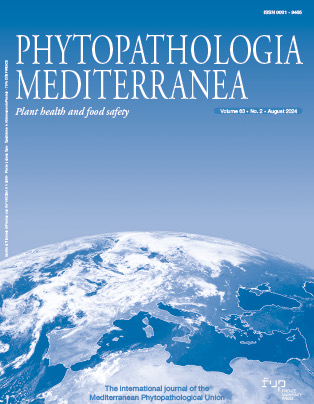Published 2024-09-16
Keywords
- Apple rootstock,
- GF-677 almond–peach rootstock,
- Grapevine rootstock,
- Tolerant crops
How to Cite
Copyright (c) 2024 Mery DAFNY-YELIN, Jehudith Clara KOHAVI-MOY, Tirtza ZHAVI, Shlomit DOR, Amber HILL, Shlomi KFIR

This work is licensed under a Creative Commons Attribution 4.0 International License.
Abstract
White root rot, caused by Dematophora necatrix (syn. Rosellinia necatrix), affects deciduous trees. A D. necatrix infection-distribution survey found widespread disease in apple and cherry orchards in northern Israel bordering a Mediterranean forest, although the forest trees were unaffected. Because cherry and apple orchards must be abandoned due to long fungal survival in infested soils, alternative deciduous fruit trees and grapevines were assessed for growth in these D. necatrix-infested orchards. In the field, grapevine rootstocks and the almond–peach rootstock GF-677 were most tolerant to D. necatrix-infested soil. Apple was the most sensitive crop, with the rootstock Hashabi being more tolerant than PI80 or MM104. The Mediterranean forest tree Pistacia atlantica, which can serve as a rootstock for pistachio, was as sensitive as kiwifruit and apple, and persimmon rootstock sensitivity was not different from grapevine. Those results show that beside the above mentioned crops, vineyards can also replace apple orchards in D. necatrix-infested soils and so broadens the list of possible crops for the local farmers in a Mediterranean climate at altitudes above 440 m above sea level. This has also been observed in a commercial 10-year-old vineyard of ‘Shiraz’ grapevines grafted on SO4 rootstock. The almond-peach rootstock GF-677 can also be grown in infested soil, but in commercial orchards requires additional treatment for adequate disease control.
Downloads
References
- Arakawa M., Nakamura H., Uetake Y., Matsumoto N., 2002. Presence and distribution of double-stranded RNA elements in the white root rot fungus Rosellinia necatrix. Mycoscience 43: 21–26. DOI: https://doi.org/10.1007/s102670200004
- Arjona-López J.M., Capote N., Melero-Vara J.M., López-Herrera C.J., 2020. Control of avocado white root rot by chemical treatments with fluazinam in avocado orchards. Crop Protection 131: 105100. https://doi.org/10.1016/j.cropro.2020.105100. DOI: https://doi.org/10.1016/j.cropro.2020.105100
- Assaf R., 1995. Les Hashabi, nouveaux porte-greffes pour la culture du pommier en Israël II-Comportement dans différentes conditions de culture. Fruits 50(2), 133–143. https://revues.cirad.fr/index.php/fruits/article/view/35469/36534.
- Dafny-Yelin M., Mairesse O., Moy J., Dor S., Malkinson, D., 2018. Genetic diversity and infection sources of Rosellinia necatrix in northern Israel. Phytopathologia Mediterranea 57(1): 37–47. https://www.jstor.org/stable/26458735.
- Dafny-Yelin M., Dor S., Mairesse, O., Moy J., 2019. The control of white root rot of apple tree caused by Rosellinia necatrix by fluazinam and prochloraz. Pesticides and Bio Fertilizers. https://www.auctoresonline.org/article/the-control-of--white-root-rot-of-apple-tree-caused-by-rosellinia-necatrix-by-fluazinam-and-prochloraz.
- Fischer M., 1996. Pillnitzer Supporter 4 (Pi 80) – A semi-dwarf apple rootstock from Dresden-Pillnitz, in VI International Symposium on Integrated Canopy, Rootstock, Environmental Physiology in Orchard Systems Acta Horticolturae 451, 99–104. https://doi.org/10.17660/ActaHortic.1997.451.7 DOI: https://doi.org/10.17660/ActaHortic.1997.451.7
- Gupta V.K., 1978. Possible use of carbendazim in the control of Dematophora root rot of apple. Indian Phytopathology 30: 527–531. https://www.cabdirect.org/cabdirect/abstract/19791354768.
- Gupta V.K., Verma K.D., 1978. Comparative susceptibility of apple root-stocks to Dematophora necatrix. Indian Phytopathology 31(3): 377–378. https://www.researchgate.net/publication/339657987.
- Gupta V.K., Gupta S.K., 1992. Management of white root rot of apple with fungicide drenching. Indian Phytopathology 45(2): 239–240. https://epubs.icar.org.in/index.php/IPPJ/article/view/21628.
- Hooijdonk V., Woolley D.J., Warrington I.J., Tustin D.S., 2010. Initial alteration of scion architecture by dwarfing apple rootstocks may involve shoot-root-shoot signalling by auxin, gibberellin, and cytokinin. Journal of Horticultural Science and Biotechnology 85(1): 59–65. https://doi.org/10.1080/14620316.2010.11512631. DOI: https://doi.org/10.1080/14620316.2010.11512631
- Kanadani G., Date H., Nasu H., 1998. Effect of fluazinam soildrench on white root rot of grapevine. Annals of the Phytopathological Society of Japan 64: 139–141. https://www.jstage.jst.go.jp/article/jjphytopath1918/64/2/64_2_139/_pdf. DOI: https://doi.org/10.3186/jjphytopath.64.139
- López-Herrera C.J., Zea-Bonilla T., 2007. Effects of benomyl, carbendazim, fluazinam and thiophanate methyl on white root rot of avocado. Crop Protection 26(8): 1186–1192. https://doi.org/10.1016/j.cropro.2006.10.015. DOI: https://doi.org/10.1016/j.cropro.2006.10.015
- Mansoori B., Dorostkar M., 2008. Reactions of some grape cultivars to Dematophora necatrix. Vitis 47(4): 231–233.
- Peres M., Grinblet Y., Doron I., 2018. Irrigation coefficients and water doses for deciduous plantations. Israel Ministry of Agriculture and Rural Development Extension Service – Professional Publications. In Hebrew.
- Picchioni G.A., Miyamoto S., Storey J.B., 1990. Salt effects on growth and ion uptake of pistachio rootstock seedlings. Journal of the American Society for Horticultural Science - ASHS 115(4): 647–653. https://doi.org/10.21273/JASHS.115.4.647. DOI: https://doi.org/10.21273/JASHS.115.4.647
- Pinochet J., 2010. ‘Replantpac’ (Rootpac® R), a plum–almond hybrid rootstock for replant situations. HortScience 45(2): 299–301. https://doi.org/10.21273/HORTSCI.45.2.299. DOI: https://doi.org/10.21273/HORTSCI.45.2.299
- Pliego C., López‐Herrera C., Ramos C., Cazorla F.M., 2011. Developing tools to unravel the biological secrets of Rosellinia necatrix, an emergent threat to woody crops. Molecular Plant Pathology 13(3): 226–239. https://doi.org/10.1111/j.1364-3703.2011.00753.x. DOI: https://doi.org/10.1111/j.1364-3703.2011.00753.x
- SangBum L., KiSung K., Aldwinckle H.S., 2000. Resistance of selected Malus germplasm to Rosellinia necatrix. Journal of the American Pomological Society 54(4): 219–228.
- Sharma Y.P., Pramanick K.K., Sharma S.K., Kashyap P., 2013. Disease reaction of apple germplasm to white root rot (Dematophora necatrix). Indian Journal of Horticulture 70(1): 130–134.
- Soumelidou K., Morris D.A., Battey N.H., Barnett J.R., John P., 1994. Auxin transport capacity in relation to the dwarfing effect of apple rootstocks. Journal of Horticultural Science 69(4): 719–725. https://doi.org/10.1080/14620316.1994.11516505. DOI: https://doi.org/10.1080/14620316.1994.11516505
- Sztejnberg A., Madar Z., 1980. Host range of Dematophora necatrix, the cause of white root rot disease in fruit trees. Plant Disease 64: 662–664. DOI: https://doi.org/10.1094/PD-64-662
- Sztejnberg A., Azaizia H., Chet I., 1983. The possible role of phenolic compounds in resistance of horticultural crops to Dematophora necatrix Hartig. Journal of Phytopathology 107(4):318–326. https://doi.org/10.1111/j.1439-0434.1983.tb00551.x. DOI: https://doi.org/10.1111/j.1439-0434.1983.tb00551.x
- Sztejnberg A., Freeman S., Chet I., Katan J., 1987. Control of Rosellinia necatrix in soil and in apple orchard by solarization and Trichoderma harzianum. Plant Disease 71(4): 365–369. DOI: https://doi.org/10.1094/PD-71-0365
- Zumaquero A., Martínez-Ferri E., Matas A.J., Reeksting B., Olivier N.A., Pliego-Alfaro F., …Pliego C., 2019. Rosellinia necatrix infection induces differential gene expression between tolerant and susceptible avocado rootstocks. PLoS One 14(2): e0212359. DOI: https://doi.org/10.1371/journal.pone.0212359






